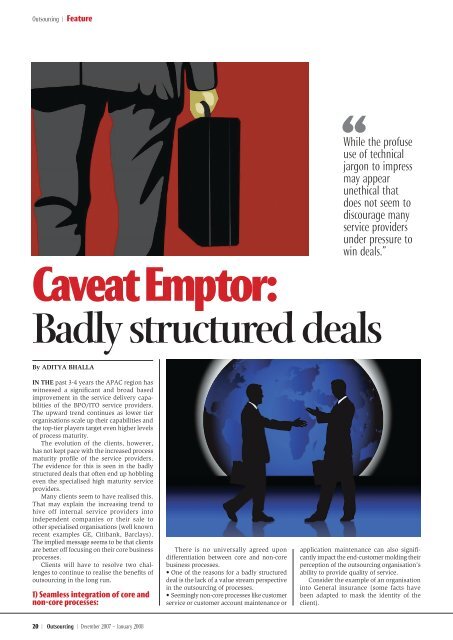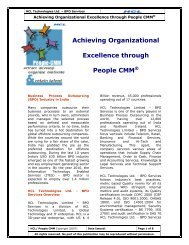Caveat Emptor: Badly structured deals - QAI
Caveat Emptor: Badly structured deals - QAI
Caveat Emptor: Badly structured deals - QAI
Create successful ePaper yourself
Turn your PDF publications into a flip-book with our unique Google optimized e-Paper software.
Outsourcing | Feature<br />
While the profuse<br />
use of technical<br />
jargon to impress<br />
may appear<br />
unethical that<br />
does not seem to<br />
discourage many<br />
service providers<br />
under pressure to<br />
win <strong>deals</strong>.”<br />
<strong>Caveat</strong> <strong>Emptor</strong>:<br />
<strong>Badly</strong> <strong>structured</strong> <strong>deals</strong><br />
By Aditya Bhalla<br />
In the past 3-4 years the APAC region has<br />
witnessed a significant and broad based<br />
improvement in the service delivery capabilities<br />
of the BPO/ITO service providers.<br />
The upward trend continues as lower tier<br />
organisations scale up their capabilities and<br />
the top-tier players target even higher levels<br />
of process maturity.<br />
The evolution of the clients, however,<br />
has not kept pace with the increased process<br />
maturity profile of the service providers.<br />
The evidence for this is seen in the badly<br />
<strong>structured</strong> <strong>deals</strong> that often end up hobbling<br />
even the specialised high maturity service<br />
providers.<br />
Many clients seem to have realised this.<br />
That may explain the increasing trend to<br />
hive off internal service providers into<br />
independent companies or their sale to<br />
other specialised organisations (well known<br />
recent examples GE, Citibank, Barclays).<br />
The implied message seems to be that clients<br />
are better off focusing on their core business<br />
processes.<br />
Clients will have to resolve two challenges<br />
to continue to realise the benefits of<br />
outsourcing in the long run.<br />
1) Seamless integration of core and<br />
non-core processes:<br />
There is no universally agreed upon<br />
differentiation between core and non-core<br />
business processes.<br />
• One of the reasons for a badly <strong>structured</strong><br />
deal is the lack of a value stream perspective<br />
in the outsourcing of processes.<br />
• Seemingly non-core processes like customer<br />
service or customer account maintenance or<br />
application maintenance can also significantly<br />
impact the end-customer molding their<br />
perception of the outsourcing organisation’s<br />
ability to provide quality of service.<br />
Consider the example of an organisation<br />
into General insurance (some facts have<br />
been adapted to mask the identity of the<br />
client).<br />
20 | Outsourcing | December 2007 – January 2008<br />
20-21(4).indd 20<br />
12/5/07 11:42:36 PM
Feature | Outsourcing<br />
Lack of a Value Stream Perspective:<br />
US General Insurance firm<br />
• This large organisation (‘Firm’)<br />
does telemarketing of insurance<br />
products to its SME (Small<br />
and Medium Enterprises)<br />
financial services clients.<br />
The telemarketing has been<br />
outsourced to more than one<br />
specialized external agency.<br />
• Outsourcing Design Flaws<br />
• Since the firm did not want to<br />
create an IT application, each<br />
vendor developed its own<br />
proprietary IT application. This<br />
created problems in integrating<br />
data received in different<br />
formats.<br />
• The Firm therefore outsourced<br />
the job of sorting the data to<br />
another agency.<br />
• This agency makes calls to<br />
customers to resolve any<br />
database inconsistencies.<br />
• All the above coupled with other<br />
design flaws led to a turnaround<br />
time of 3-4 weeks for confirmed<br />
orders waiting to be processed.<br />
Additionally, customers felt<br />
hassled by the duplication of<br />
effort.<br />
• The firm was losing confirmed<br />
orders lying unprocessed in the<br />
system.<br />
• Ironically, no one was looking at<br />
the value stream perspective or<br />
had an estimate on the revenue<br />
leakage on account of lost<br />
orders.<br />
• A subsequent study established<br />
the potential revenue leakage<br />
estimate at US$500,000.<br />
2. The Techno-babble trap<br />
Even after outsourcing, clients will need<br />
to retain the ability to understand the finer<br />
nuances of running the outsourcing business<br />
to effectively audit the operational capability<br />
of the service providers.<br />
This is because the increased pressure on<br />
service providers to differentiate themselves<br />
from others coupled with the relative<br />
inability of the clients to discern the finer<br />
technical nuances has encouraged some<br />
service providers to resort to techno-babble<br />
to win badly <strong>structured</strong> <strong>deals</strong>.<br />
Techno-babble manifests itself in two<br />
ways:<br />
a) Technical blind spot on best practices for<br />
managing the process<br />
Examples of techno-babble blindspot<br />
in IT industry<br />
• Software Architecture: Software<br />
architecture is an evolving field<br />
in the IT industry. However,<br />
that does not stop many IT<br />
companies from brandishing<br />
multi-tier software architecture<br />
software platforms. Industry<br />
experts call such diagrams<br />
‘markitectures’ or at best a<br />
technology stack.<br />
• Such architectures are at many<br />
times divorced from the realities<br />
of the variety of end-user<br />
problems to be solved and/or<br />
even the Business Requirement<br />
Document.<br />
• Software testing: Many players<br />
are also unaware of leading<br />
practices in ensuring test plan<br />
coverage leading to sub-optimal<br />
test plan creation often based<br />
on exclusive focus on testing of<br />
software features.<br />
• One bank discovered in the<br />
pre-product launch phase that<br />
the testing team of an MNC<br />
service provider was going<br />
through the motions of testing<br />
the new software platform<br />
oblivious of the fact that the<br />
business logic governing the<br />
process had conceptual flaws<br />
exposing the bank to potential<br />
fraud opportunities.<br />
Examples of Techno-babble Blindspot<br />
Trap in BPO industry<br />
• Six sigma Graphical Purgatory: Examples<br />
of impressive and complex looking six sigma<br />
project presentations with incorrect analysis<br />
and misguided solutions exist even for the<br />
higher maturity service providers.<br />
• Inconsistent operational definitions:<br />
Inconsistent interpretation of how to define<br />
and track performance metrics is another<br />
bane of the BPO industry.<br />
• This is one area where many clients are<br />
equally remiss in ignoring the advice of their<br />
service providers.<br />
• The stated reason is the move towards<br />
standardization of practices (incorrect?)<br />
across the world. The downside is that<br />
improving the customer experience remains<br />
an elusive dream.<br />
Existing differences … the evolution of the clients<br />
has not kept pace with the increased process<br />
maturity profile of the service providers.<br />
b) Profuse use of technical jargon to<br />
impress: While this approach may appear<br />
unethical that does not seem to discourage<br />
many service providers under pressure to<br />
win <strong>deals</strong>.<br />
Examples of techno-babble<br />
technical jargon traps<br />
• Six sigma and Process<br />
Capability:<br />
1. One common practice in IT<br />
industry is declaring impressive<br />
entity level process capability<br />
baseline based either on<br />
statistically insignificant project<br />
data or incompatible projects.<br />
This is more so for organisations<br />
competing under pressure to<br />
obtain CMMi high maturity<br />
assessments.<br />
2. For the BPO industry six sigma<br />
has provided many organisations<br />
the ability to claim high<br />
performance capabilities based<br />
on indefensible performance<br />
targets.<br />
The above examples are<br />
representative of the outsourcing<br />
design problems endemic to the<br />
service industry.<br />
For the outsourcing wave to<br />
succeed in the long run, clients<br />
will have to evolve the internal<br />
vendor management support<br />
structures and retain the technical<br />
competencies to ensure that the<br />
end-customer does not turn out to<br />
be the biggest loser undermining<br />
the objectives of outsourcing.<br />
Aditya Bhalla is a senior consultant with <strong>QAI</strong><br />
Innovation Practice. He is a certified Master<br />
Black Belt, I-TRIZ IPS and AFD trainer,<br />
CSQA, COPC Coordinator. His client engagements<br />
include Citibank, Credit Suisse, HP,<br />
Trend Micro, Reliance, Tata Teleservices,<br />
HCL BPO, MinDef Singapore and many<br />
others. He can be contacted at aditya@<br />
qaiindia.com<br />
December 2007 – January 2008 | Outsourcing | 21<br />
20-21(4).indd 21<br />
12/5/07 11:42:37 PM
















